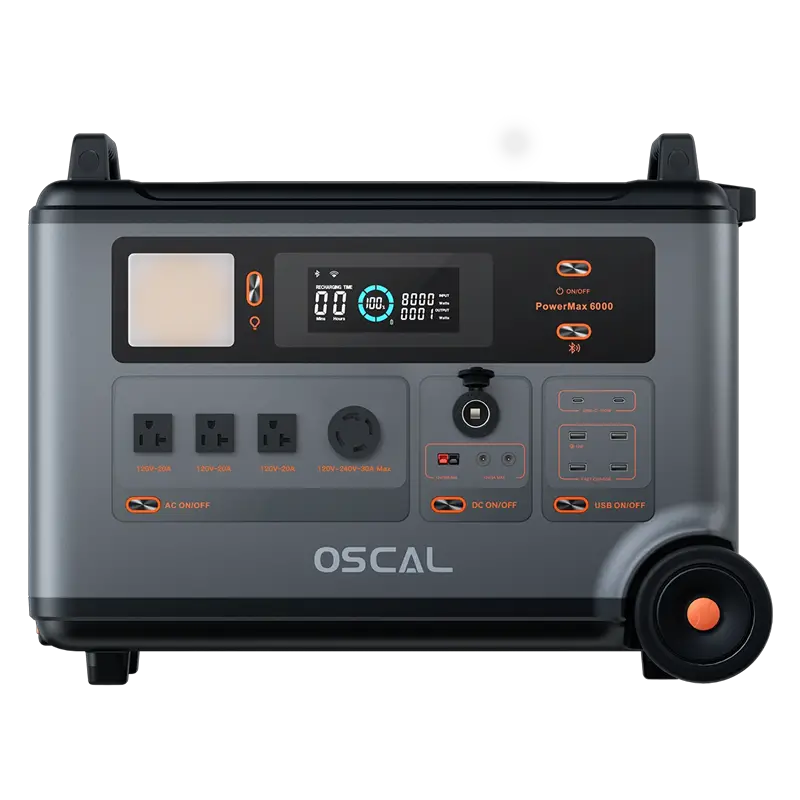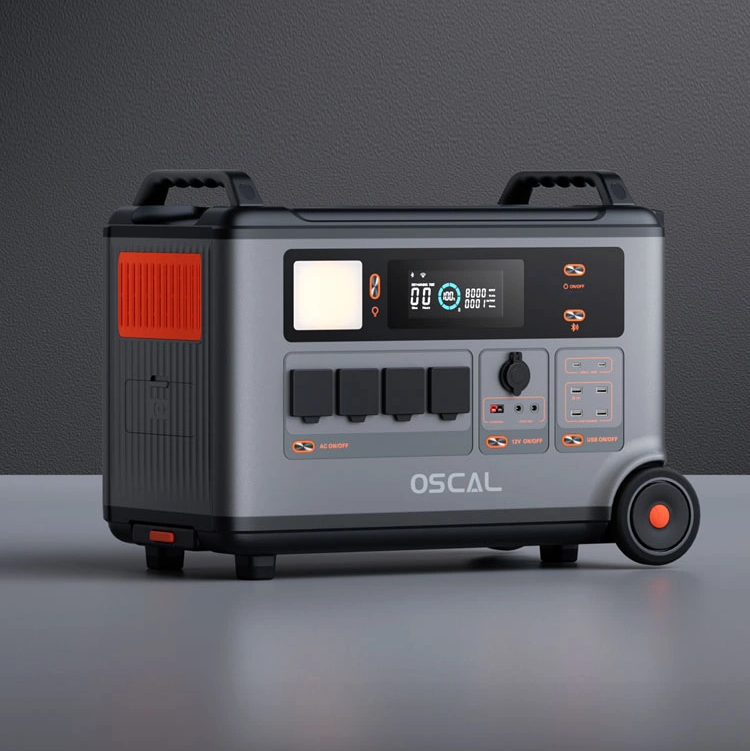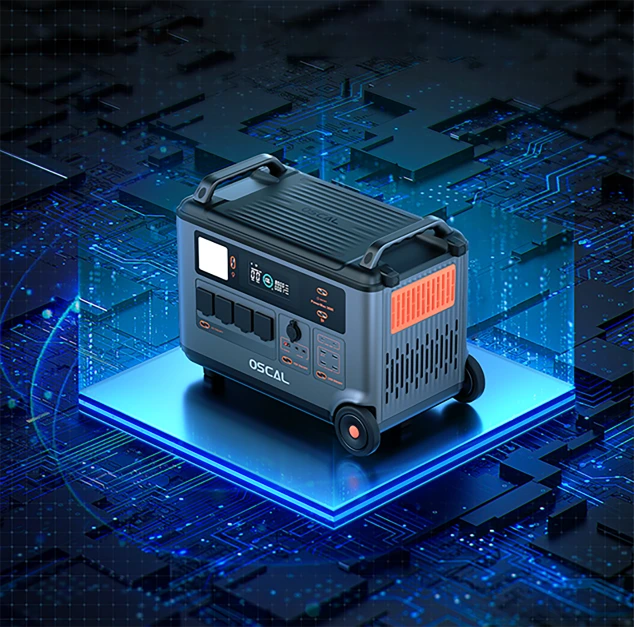



The Oscal PowerMax 6000, announced in June 2024 and released in July 2024, is an advanced iteration of the PowerMax 3600, designed to meet higher power demands with enhanced capabilities. This new model retains the robust features of its predecessor while introducing several significant upgrades.
The PowerMax 6000 maintains the same dimensions as the PowerMax 3600, measuring 590 x 350 x 441 mm, but weighs slightly more at 101.41 lbs (46 kg) compared to the previous 96.10 lbs (44.45 kg). Both models feature splash and dust-proof protection, making them suitable for outdoor use and rough conditions.
The PowerMax 6000 uses the same LiFePO4 (Lithium Iron Phosphate) battery technology as the PowerMax 3600, which should translate to long battery life usage and safety. The capacity remains at 3,600Wh, but the total output power has been significantly increased to 6,000W, with a surge power of 9,000W, compared to the 3,600W output and 7,200W surge power of the PowerMax 3600. This substantial increase in power output makes the PowerMax 6000 capable of handling more demanding electrical loads.
The new model offers improved charging capabilities. The AC input power has been increased to 2200W from the previous 2000W, and the solar input capacity has been raised to 2400W from 1600W. The car input has also been doubled to 240W. These enhancements result in faster charging times: 1.96 hours for AC, 1.5 hours for solar in prime conditions, and a maximum combined AC and solar charging time of 1.44 hours, compared to the PowerMax 3600's 2 hours for AC and 2 hours 15 minutes for solar.
The PowerMax 6000 provides a wider range of output options, supporting a total output power of 6,000W through four AC outlets. It includes the same USB and DC outlets as the PowerMax 3600, with 2x PD 100W USB Type-C, 3x PD 18W USB Type-A, and 1x PD 12W USB Type-A ports. The cigarette lighter socket remains the same, offering 120W. Additionally, it has 1x 12V/25A (Anderson 378W outlet) and 2x 12V/3A DC5521 (5.5mm outlet) DC outputs.
Both models come equipped with industrial wheels and an extendable handle for easy mobility. The PowerMax 6000, however, includes a 5-level LED lamp, an upgrade from the basic LED light on the PowerMax 3600. The management system in both models is powered by the T1 chip, which monitors load, voltage, charging, and temperature for optimal performance and safety.
The PowerMax 6000 holds certifications from Europe (CE/RED/ROHS), America (FCC/DOE/CEC/FCC/UL), and South Africa (IEC62368), for better compliance with international safety and performance standards. Like its predecessor, it comes with a 4-year warranty. The table below contains the full specifications of Oscal PowerMax 6000 Power Station.
| Launch This refers to the date when this device was officially introduced into the market. | 2024, June / 2024 July |
| Brand / Model These are key identifiers that indicate the manufacturer or company that produces this smartphone, and the specific model of the phone. |
Oscal / PowerMax 6000. - Also known as Blackview Oscal PowerMax 6000 |
| Dimensions / Weight: This refers to the physical size and weight of the device, measured in millimeter (mm) and grams (g) respectively. | 590 x 350 x 441 mm / 101.41 lbs. or (46kg) |
| Protection These refer to the measures and technologies used to safeguard the device's display from scratches, cracks, and damage. Common types of screen protection include Tempered Glass, Gorilla Glasses, IP Rating, etc. | Splash and Dust Proofed |
| Temperature The temperature in a mobile power station or power bank refers to the level of thermal energy present within the device during its operation. It's typically measured in degrees Celsius (°C) or Fahrenheit (°F) and indicates how hot or cold the internal components of the power bank are during usage. |
Storage: -10℃ to 45℃ or (14°F~113°F) - Charging: 0℃ to 50℃ or (32F to 122F) - Discharging: -20℃ to 55℃ or (-4F to 131F) |
| Battery Type In portable power stations, battery type refers to the specific chemical technology used to store electrical energy. This choice significantly impacts factors like the weight, lifespan, safety, and charging speed of the station | LiFePO4 (Lithium Iron Phosphate) |
| Battery Capacity Battery capacity in a portable power station refers to the total amount of electrical energy it can store, measured in watt-hours (Wh). It essentially tells you how long the station can power your devices. | 3,600Wh |
| Lifecycle This indicates the number of times you can completely discharge and recharge the battery (one cycle) before it loses 20% of its original capacity. In simpler terms, this tells you how many times you can use and recharge the station before it becomes noticeably less powerful. | 3500+ Cycles to 80% of Original Capacity |
| Shelf-Life This refers to how long the battery can maintain its charge when not in use. Over time, even if the station isn't being used, the battery will slowly lose its charge. This specification tells you how often you need to recharge the station even if it's just sitting in storage or on the shelf. | Recharge to above 50% Every 3 Months |
| Management System This refers to all measures put in place to ensure the optimal performance and safety of your Portable Power Station. |
T1 Chip integrated with BMS - Load / Voltage Monitoring - Charging Monitoring - Temperature monitoring |
| Charging Type (Input Option) In portable power stations, charging type refers to the methods available to recharge the battery. |
AC Input: up 2200W - Solar Input: up 2400W Max. - Car Input: up 240W from Cigarette Lighter Port |
| AC Charging Time AC charging time for a portable power station refers to the time it takes to recharge the station from a standard AC wall outlet. | 1.96 hours |
| Solar Charging Time Solar charging time for a portable power station refers to the amount of time it takes to recharge the station's battery using a solar panel. | 1.5 hours (Prime sunshine) |
| AC + Solar Charging Time AC + Solar Charging time refers to the time it will take when both AC wall outlet and a Solar panel is combined to recharge your Portable Power Station. | Max 3000W Supported; 1.44 hours |
| Car Charging Time Car charging time for a portable power station refers to the amount of time it takes to recharge the station's battery using the cigarette lighter outlet (also known as a 12V DC outlet) in your car. | 15 hours |
| Total Output Power This represents the maximum continuous power (measured in watts) that the portable station can deliver to your devices at any given time. It essentially tells you the total amount of power available for running your appliances simultaneously. | 6,000W |
| Inverter Type This refers to the type of electrical current the station generates through a process called inversion (converting DC battery power to AC power). There are two main types: Pure Sine Wave or Modified Sine Wave. | Pure Sine Wave |
| Surge Power This indicates the maximum short-term surge of power (measured in watts) that the station can handle for a brief period (usually a few milliseconds). This can be helpful for starting up devices with high initial power demands, such as motors in refrigerators or power tools. | 9,000W |
| AC Outlets These are the standard AC (alternating current) outlets that you'd use to plug in your devices with AC power cords. | 4 X AC Outlets (Total 6000W) |
| USB Ports These are the USB ports available for charging various devices using USB-C or USB-A cables. |
2x PD 100W - USB Type-C 3x PD 18W - USB Type-A 1x PD 12W - USB Type-A |
| Cigarette Lighter Sockets This is a 12V DC (direct current) outlet similar to the cigarette lighter socket found in your car. It allows you to power 12V DC appliances, such as car chargers, portable coolers, or some lights. | 1 x Cigarette Lighter - 120W (Car Outlet) |
| LED light An LED light, in the context of a portable power station, refers to a built-in light source that uses light-emitting diodes (LEDs) for illumination. These lights are typically small, energy-efficient, and durable. | Yes; 5 level LED lamp |
| DC Outlets DC outlets in a portable power station are ports that provide direct current (DC) electricity, typically at 12 volts. This is different from the standard AC (alternating current) outlets that you'd find in your house. |
1 x 12V/25A (Anderson 378W Outlet) 2 x 12V/3A DC5521 (5.5mm Outlet) |
| Box Contents This section refers to all the items, tools, accessories, and cables contained in the box. |
Oscal PowerMax 3600 - AC Charge Cable - Solar Charging Cable - Car charging cable - User Manuals |
| Warranty A warranty on a portable power station refers to a guarantee provided by the manufacturer that the product will be free from defects in materials and workmanship for a specified period of time. | 4 years |
| Certifications Certifications for portable power stations signify that the product has been tested and meets specific safety and performance standards set by independent organizations. |
- Europe: CE/RED/ROHS (EU) - America: FCC /DOE/CEC/FCC/UL - South Africa: IEC62368 |
| Color Options In the context of portable power stations, "Color Option" most likely refer to the variety of colors the station itself comes in. | Grey |
| Others This is a catch-all category that includes various additional features, specifications, or capabilities that don't fall under the major categories like display, camera, memory, or connectivity. |
Industrial wheels - Extendable handle |
These specifications were entered manually, hence we CANNOT guarantee 100% accuracy. Also, that your device is listed on this website DOES NOT call for reckless usage! It is crucial to exercise due diligence, as we cannot be held responsible for any damage to your device due to overconfidence in it built quality.
Leave a Reply